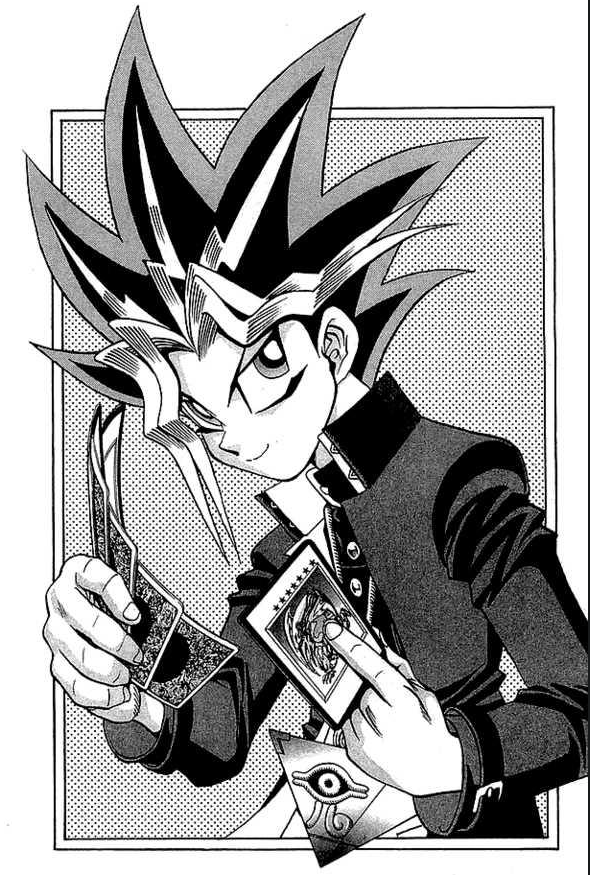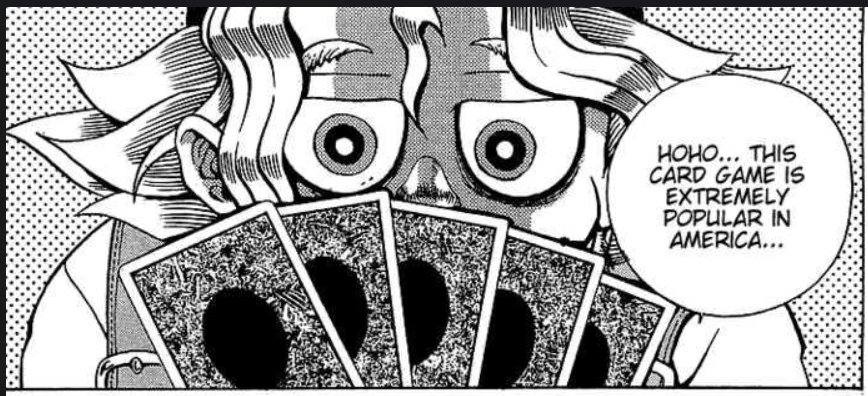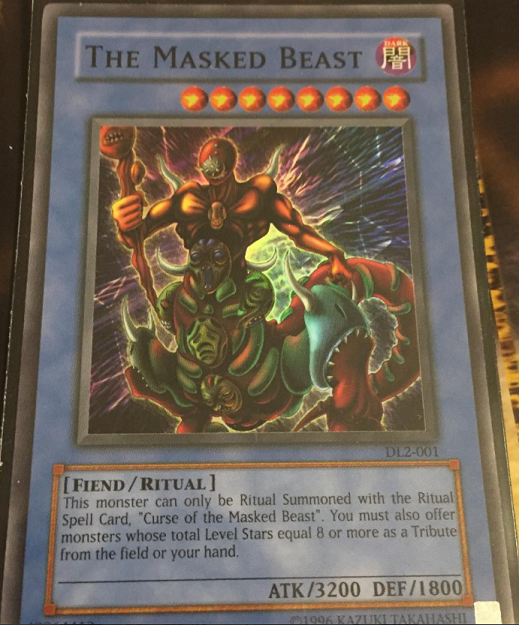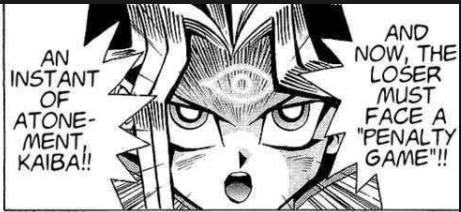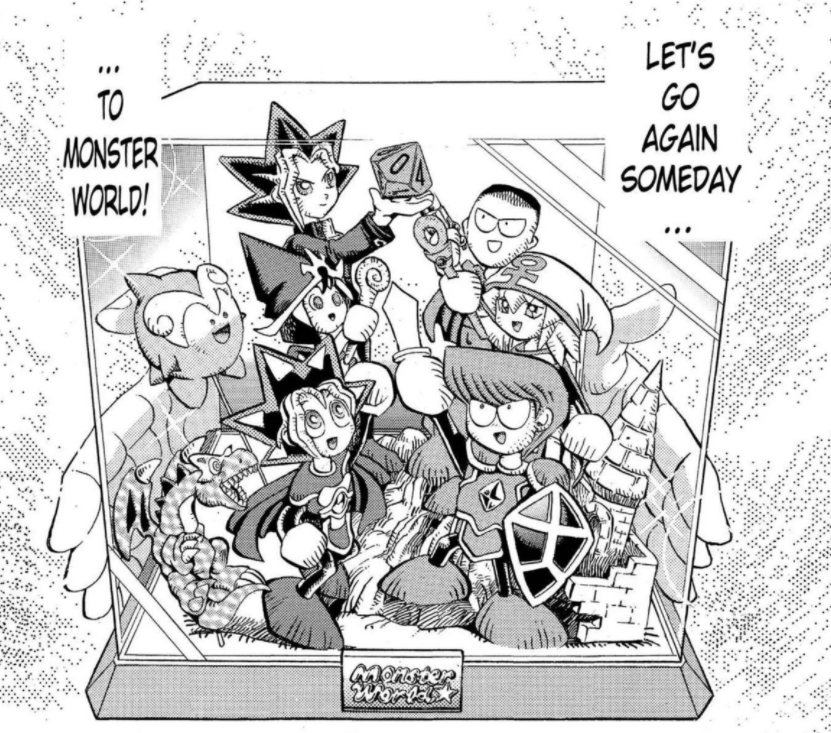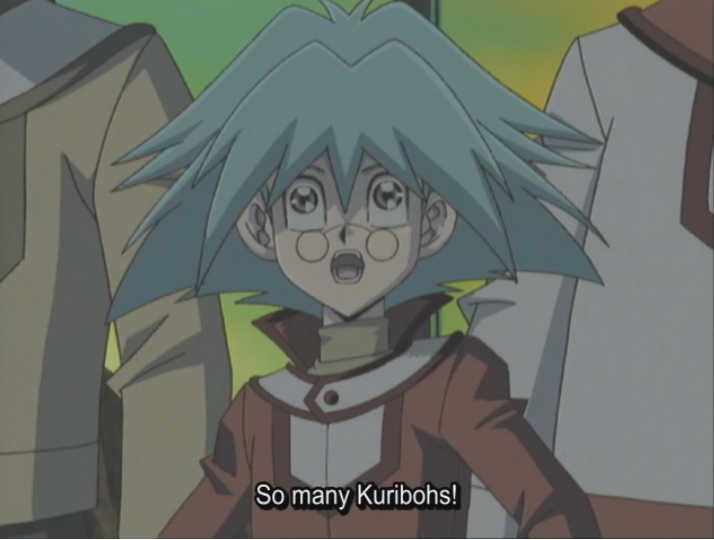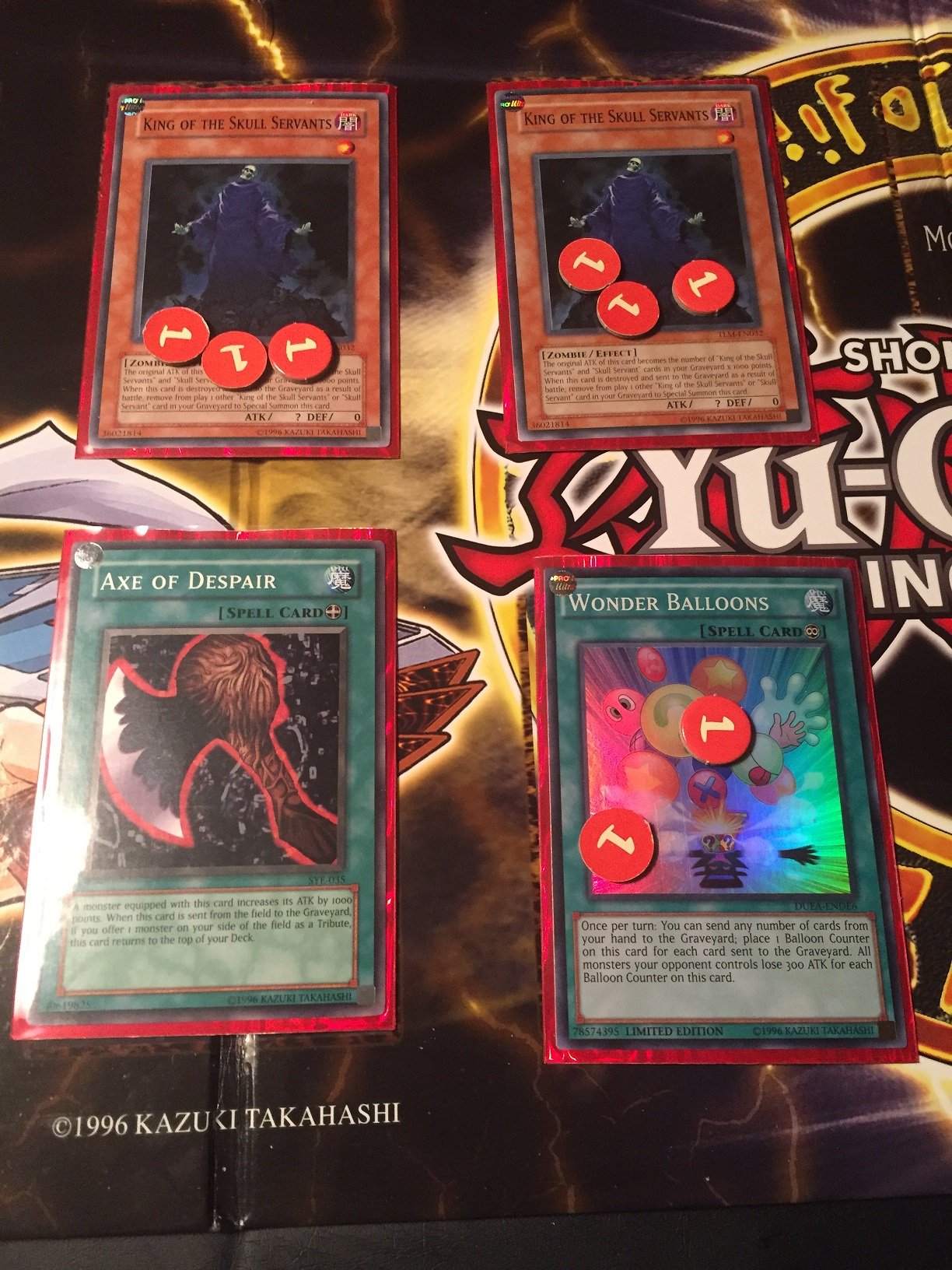050: SoraRabbit Plays a Shadow Game
So I did it… I made it to 50 posts! More than that if you count all the Short Hops and Video Game posts. This is a pretty big deal for me, so I wanted to do something special with it. (And also something somewhat easy because my holiday posts are fast approaching.) After thinking about it for a bit, I decided it was time to tackle a topic I’ve wanted to talk about from the beginning of this blog… a game that is near and dear to me. Yu-Gi-Oh!
Yami Yugi (Credit: Kazuki Takahashi, Konami)
I'll just be right up front about this: I love Yu-Gi-Oh. I never expected to, but I do all the same. I've long wanted to do a post about Yu-Gi-Oh, but I couldn't exactly figure out how to go about it. This is a manga that became a card game, that became an anime, and from there it expanded and has gone on for 24 years. How could I tackle something this big? I could do a post about the manga, the card game, the anime, the other animes, the video games… each of those could be their own post. There’s just so much there! Doing a full history of Yu-Gi-Oh would be too big an undertaking, and likely not all that interesting. Reviewing the anime and manga would probably be good at some point, but not for the first post. The game, anime, and manga have all meant so much to me that I didn’t want a clinical explanation of it all. I wanted to do something that would do it justice, talk about the impact it’s had on me.
And then it came to me— at two AM when I should have been sleeping and had to drag myself out of bed to scrawl down some notes so I wouldn’t forget— the post could follow my history with Yu-Gi-Oh from the start to present day! This is the perfect way to handle it, since it would make it more personal and would cover all aspects of the franchise. (If this works I may use the same format for Pokemon. Eventually I’ll cover everything I love in this blog… it’s just a matter of time.) So here we go... SoraRabbit's take on the long-running card game and media phenomenon of Yu-Gi-Oh!
Little did Grampa Muto know just how true that comment would become. (Credit: Kazuki Takahashi, Konami)
First a little background. Yu-Gi-Oh (stylized as Yu-Gi-Oh! but I’m not going to put the exclamation point on there for this post) is a media franchise that began as a serialized manga in Shonen Jump in 1996 in Japan. The name literally translates to “King of Games” but it’s also a play on the name of the main character Yugi Muto. The boy finds a mysterious box in his grandfather’s belongings that contains the Millennium Puzzle, an upside-down pyramid that can be worn as a (ridiculously oversized) pendant. After he completes the puzzle, he becomes possessed— the puzzle contains a spirit that takes over Yugi’s body at times of great stress. The spirit is referred to as Yami, and turns out to be the spirit of an ancient Egyptian Pharaoh whose name has long since been forgotten. The manga was hugely popular, with the most-read stories being about a card game that would go on to form the basis of the real-life card game. It soon became two anime series, one based on the first few volumes of the manga, the other based on the rest of the series. The story has branched off into spin-off manga, additional anime series, movies, video games, toys, and real-life tournaments.
The legendary Dark Magician! (Credit: Kazuki Takahashi, Konami)
Until Sora Junior was born in 2003, Yu-Gi-Oh wasn’t even a blip on my radar. I will never forget my introduction to it. See, I was the one who always got up with SJ to feed him. As many of you are aware, having a new baby in the household usually causes a long-term lack of sleep. I truly feel like my attachment to Yu-Gi-Oh first came about due to my sleep deprivation. (Make of that what you will.) As newborns do, he would wake up at odd times to eat and need changing and sometimes just because. (He had a lot of trouble sleeping when he was little.) So for the first few weeks of his life, I was incredibly sleep deprived. Thankfully (and also unfortunately) I lost my job shortly after he was born. Anyway, all that is to say that he and I were on a very chaotic and unpredictable schedule for a few months before he finally started sleeping through the night.
One of those exhausted feedings took place in the afternoon on a weekday and I often turned on the TV to have something to focus on in the background while giving him his bottle. As I was flipping through the channels I caught the familiar art style of anime so I stopped to see what it was. I was instantly confused. It appeared to be a bunch of kids with crazy hair screaming at each other dramatically about a card game. It was baffling, hard to follow, and oddly engaging. I drifted in and out, but whenever I was awake, it held my fragmented attention. From then on when his feedings would line up right and I wasn’t catching a quick nap, I made it a point to tune in. We would watch this peculiar show and I would struggle to make sense of it and figure out why this card game had them so worked up.
After SJ’s sleep got better (and mine as a result) I decided to see what was going on with the weird show that I now knew as Yu-Gi-Oh Duel Monsters. The nearest I could figure was that the monsters on the cards came to life and the fate of the players— and sometimes the world— would ride of these card matches… or duels, as they were known. (Later, of course, I learned the monsters were just holograms.) I wasn’t curious enough to try and track down the show from start to finish, which was a much more difficult and expensive task in those days than it is now in our age of infinite streaming services and instant entertainment. Back then we would need to track down video tapes or DVDs which usually contained a whopping two episodes each for about $20 or so. For a show that had been going on for several years, that would be prohibitively pricey. The other option, of course, was to wait for the network to reach the end of the episodes so that the reruns would start over.
As I was waiting for this to happen, on one of my trips to a video store I found a discount-priced PlayStation 2 game called Yu-Gi-Oh: The Duelists of the Roses. This was a weirdly-historic-themed loose adaption of the card game. And I mean LOOSE. It hardly followed the rules at all, and the monsters were summoned on a chess-board setting where they would move around and battle. It did include many of the real life cards and the characters from the anime in historical roles (vaguely based on the actual Wars of the Roses from 15th century England. It was a really weird concept. The description of the game and the pictures (plus the fact that it came packaged with three exclusive cards) sold me on it, so I bought it.
The first three cards I acquired. It was a slippery slope. (Credit: Kazuki Takahashi, Konami)
Overall, it was a somewhat forgettable video game, but I enjoyed it. I loved the cards immediately. The art was cool and they were shiny. (And you all know how much I love shiny things.) There was just something about holding those actual cards that looked like the ones from the game and anime that was… I don’t know… thrilling? It was like artifacts brought to life. I still knew nothing about the actual card game, nor did I intend to ever play it. I remember thinking something along the lines of “These are really cool cards, but they’re the only three I’ll ever have.” Little did I know…
Soon after getting that first video game, I bought a used copy of Yu-Gi-Oh Forbidden Memories for PS1. (I got that one used, so it didn’t come with cards.) This one was much more like the actual card game, but the rules were changed in very strange ways. (No tributes required, cards could be fused with pretty much any other card, each card had elemental attributes that affected their attack and defense, you could place cards in facedown attack mode, and more.) I enjoyed this game, and it’s probably what really got me more curious on how the game was actually played.
By this point we were living at my mom’s house (long story) and I had a new job with 10 hour shifts that afforded me the chance to have three day weekends. Yu-Gi-Oh had started over on Cartoon Network, so I started taping it and binge watching the episodes when I could. I started to understand the card game and the plot a whole lot more as i watched it from the beginning. After a time, I even got my brothers somewhat invested in the anime. When they weren’t out living their busy teenage lives, they would sit and watch episodes with me. (The show has a way of sucking you in. Give it a try if you don’t believe me.)
So at this stage I would have to say that I was a fan of the series and increasingly curious about the card game. Wandering through a department store one day I came across a volume of the manga and I thumbed through it, becoming ever more confused and intrigued. It was clearly about Yugi and his friends and had the same art style, but there were no cards to be found! And some of the names were different. (Tea was Anju, Joey was Jonouchi.) The weirdest thing about it was that it was very dark when compared to the anime. Yami Yugi appeared to be sadistic and would punish evil-doers. I didn’t pick up the manga that day, but I’d gotten my first taste of the origins of Yu-Gi-Oh.
I was thrilled to get these. These are pieces of my history. (Credit: Kazuki Takahashi, Konami)
So, a little ways into watching the anime, I was in a toy store and found a double deck set. The set contained both the Yugi and Kaiba starter decks, with the box art cut so that the two boss monsters could show through. They were cards I had become familiar with in the anime, two very important cards to the series: Yugi’s Dark Magician and Kaiba’s Blue-Eyes White Dragon. I want to say the set was $30 and I was horrified at the thought of spending that much on cards… especially for a card game that I had never played. But seeing these iconic cards in person, all shiny and manifested in reality like this was too tempting. I gave in and bought the set and from that moment on I was lost to the world of the Yu-Gi-Oh Card Game.
The set also came with a rule book and a DVD that taught me how to play. I studied these, looked through all my new cards, and added my Magnet Warriors to the Yugi deck. To my amazement I picked up the rules much more quickly than any of the card games I had tried before.
See, the reason why this is significant is because when I was younger I had friends attempt to teach me Magic the Gathering and my brothers tried their hardest to get me to grasp the Pokemon TCG. Both eluded me. It’s weird considering how many games I’ve learned in my life, but I just couldn’t wrap my brain around the rules and mechanics for those collectible card games. But when I learned Yu-Gi-Oh, I picked it up rapidly, to the point where the next day after I learned, I was teaching others how to play. I’ve since gotten over my block and figured out how to play both Magic and Pokemon, but they’ve never had the hold over me that Yu-Gi-Oh does.
The first card I traded for. No regrets. (Credit: Kazuki Takahashi, Konami)
I taught my then-wife how to play and she soon became hooked too. I bought her the Joey and Pegasus starter decks and we started playing all the time. I even taught my brothers the game and played a couple of times with them, but it never really held their attention. At that time I was getting into lots of things: Manga, Adult Swim, Cowboy Bebop, FLCL, and more. But Yu-Gi-Oh became a passion of mine. I got a few Gameboy games and played through them. (They were much more accurate to the rules but pretty archaic by today’s standards.) I studied the game, visited online forums, pored over the rules and strategies, reviewed the ban list and card set lists. I got magazines and even started buying booster packs to beef up my two decks and start to build new ones. We didn't live in the city at that point… my mom’s house was an hour round trip away from where we used to live, so that was quite the time investment to drive out and get cards. It was worth it though— I loved getting booster packs. They were all about potential. Anything in the set could be in the pack. The set that I started getting boosters for was called Invasion of Chaos and it introduced super rare game-changing monsters named Chaos Emperor Dragon Envoy of the End and Black Luster Soldier Envoy of the Beginning. These were cards that pretty much blew up the game for a while before being banned, and it was fun getting into the culture of the game during this time. (I did eventually end up pulling both those cards first edition, and they’re still prized parts of my collection.)
Grampa got served. (Credit: Kazuki Takahashi, Konami)
At this point I’ll pause briefly to talk about the anime. Duel Monsters was actually the second anime. The first one only had 27 episodes and one movie, adapting the beginning of the manga series. (Honestly that series wasn’t that great. I watched it way later and didn’t like it much.) Duel Monsters was where Yu-Gi-Oh really started catching on in America. It ran for 224 episodes from 2000 to 2004. It encompassed the last 31 volumes of the manga and added a lot of additional material. (Note that I had not seen all of the series at this stage, just the first few arcs.) The anime followed Yugi and his friends as they play Duel Monsters against various opponents, collect the Egyptian God Cards, and learn the secrets of the Millennium items. They often found themselves battling supernatural forces in high stakes duels known as Shadow Games. It was exciting, entertaining, and more than a little absurd. (But that was part of the fun!)
In 2004 a movie came to theaters called Yu-Gi-Oh! The Movie: Pyramid of Light. The stores had a tie-in booster pack containing cards that were used in the movie. You also got two of four promo cards with your ticket. (The DVD had a mail-in offer to get the other cards.) The movie itself was a little silly, clearly aimed for American audiences and was of questionable canonicity to the anime. I say this because Yugi’s origin is slightly changed and many things happen in the movie that are never referenced again in the series. I remember very much enjoying seeing the movie in the theater, but watching it again over a decade later it was sort of laughable, especially when compared to the anime it was based on.
Now I figure I should briefly touch on how the game works. In short, you construct a deck of at least 40 cards made up of monster cards, spell cards, and trap cards. You can also create an Extra Deck for special monsters and a side deck to swap cards in and out in tournament play. Two players take turns summoning monsters, setting traps and activating spells with the intention of reducing the opponent’s life points from the starting value of 8000 to 0. Some bigger monsters require tributes— sacrificing other monsters on the field. There are many ways to special summon monsters but typically you’re allowed one normal summon a turn. Monsters can be summoned in face up attack mode or set in face down defense mode. In battle, if your monster’s attack points are higher than the opponent’s attack (while in attack mode) or defense (while in defense mode) then the opposing monster is destroyed. Any extra attack spills over to the opponent’s life points as battle damage. Monsters can have effects that change the game in various ways. Spells and traps also alter the play by destroying monsters, eliminating opponent’s spells and traps, searching the deck, and more.
That’s the bare bones. Essentially you’re in a struggle to defeat your opponent before they defeat you and your deck of cards is your weapon to accomplish that goal. From there it gets much more complicated, with fusion monsters, ritual monsters, monsters that utilize the graveyard, hand traps, cards being removed from play, alternate win conditions, and much much more.
This card is a real killer. (Credit: Kazuki Takahashi, Konami)
The game is released in booster sets several times a year and the occasional collector’s tin. Starter and structure decks are also released as a preconstructed, ready-to-play option. Booster packs allow you to customize the decks. Periodically Konami changes the gameplay a bit, altering rules and introducing new mechanics. The game board has been altered a few times to match the new mechanics and a new method of playing called Speed Duels was introduced. They’ve brought in new types of monsters called Syncro, XYZ (pronounced ick-zees), Pendulum Monsters, and Link Monsters.
Anyway, back to my history lesson. I had fun playing with my then-wife, but she really wasn’t the best sport. She would trash talk, which is not something I engage in. When I would win she would invariably spend the next ten minutes to an hour retooling her deck before challenging me again. She hated to lose and never really learned how to lose gracefully. (That’s never been a problem that I’ve had.) This was frustrating because I would sit around waiting to play again, but from my point of view it was better to deal with this than to not play at all. I would oftentimes let her win to avoid her pouting and retooling.
So the years passed and things changed in my life, as they do. My marriage ended and I didn’t do much with Yu-Gi-Oh for several months. Then I got into a new relationship and one night I carefully taught my next girlfriend to play. We only played the one time. I tried so hard to let her win, thinking this would encourage her to keep playing, but I still ended up beating her. After she lost, she stood up, walked away without a word, and shut herself in the bedroom for a couple of hours. (She turned out to be even more competitive than my ex.) She never brought it up and I never asked her to play again. After we broke up, I tried to get a friend into the game but nothing ever came of that.
After this I felt like I was doomed to never play again. The video games were okay, but they didn’t really compare to playing against a live, thinking and strategizing opponent. I was in no way interested in playing against strangers at the local game shops. (Part of it was that I’d started ignoring the ban list so I wouldn’t have to constantly change my deck. The main reason was because at the time I was suffering from pretty bad social anxiety. Also I didn’t like strangers, most of whom would likely have been much younger than me.) So instead I busied myself reading the manga and still occasionally read through the forums and got a booster pack here and there. The thrill had gone out of it, though. What was the point in getting shiny new cards when I would never get to play with them? It was sad because I was cut off from the game I loved… it was like losing a friend.
And then I met Cocoashade.
Uh… right. (Credit: Kazuki Takahashi, Konami)
But before that we’ll talk about the manga! As I mentioned earlier, the manga at first didn’t much resemble the anime that came after. In the beginning of the manga series, the stories were mostly self-contained and followed a sort of “game of the week” format. There were card games, dice games, games of risk or chance. There were puzzles, board games, even digital pets. Some games were originals designed by Takahashi such as Capsule Monster Chess, Dungeon Dice Monsters, and Clock Solitaire.
The stories involved Yugi and his friends getting into normal teenage situations. They had to deal with bullies, social problems at their high school, crushes, expensive sneakers, you know, usual teen stuff. When Yugi would find himself in danger, he would disassociate and his dark passenger would take over… the spirit of the Millennium Puzzle. This spirit was referred to for a time as the “other Yugi” and then eventually Yami (which means dark/darkness in Japanese) or the Pharaoh as the series continued. Eventually Yugi and his friends became aware of Yami and managed to communicate with him. Yugi and Yami looked very similar, but when Yami was possessing him, he would get taller and more confident (cocky, really) and his voice would change.
This manga gets dark. (Credit: Kazuki Takahashi, Konami)
The first seven volumes of the manga were super dark. No, really… I can’t stress enough how dark and troubling this series was at first. Don’t get me wrong, I love it and the feel of it is something the series lost somewhat over time. However it was pretty violent and gruesome and I can see how it could be jarring to fans who only knew the comparatively light-hearted anime. I know it was jarring to me at first.
Yugi and his friends, often cheerful and excited about something new and fun, would usually be brought down by some sort of bully or authority figure. (There was a lot of violence against the children.) Yami would take over and challenge the antagonist to a “penalty game”… a sort of wager where the loser would be punished in an ironic and often permanent fashion. The games were never rigged, rather they were aimed to take advantage of the antagonist’s hubris. For example when a thief stole their expensive designer sneakers, Yami put coins and a scorpion in one of the shoes. Yami and the thief took turns scooping out coins, and whoever got the most coins would be declared the winner. But they would have to move fast or risk being stung by the scorpion. The bad guy decided to grab them all at once, not realizing his clenched coin-filled fist would be too big to fit through the mouth of the sneaker. He was subsequently stung and the shoes were recovered. The fate of the bad guy was not given, but Yami likely left him for dead.
Some of the penalty games strongly implied death. Other punishments included hallucinations, permanent sensory manipulation, catatonic states that may or may not be permanent, public humiliation, and more. The worst end of the spectrum included electrocution and immolation. (Pretty sure the criminal who was set on fire didn’t walk away from that.) One particularly vain teacher who embarrassed Honda in front of his crush had her face made into a puzzle, which then fell apart, showing her true ugliness under all the makeup she hid behind. (At least that’s the interpretation everyone goes with. When I first read it I took it as she was scarred for life by the penalty game, but it’s not usually shown what happens to the victims after Yami’s interference.)
I love this arc. (Credit: Kazuki Takahashi, Konami)
The first seven volumes of the manga continued in this vein, and gradually moved towards a more serialized approach with the introduction of Shadi, a mysterious Egyptian man with two artifacts known as the Millennium Scales and Millennium Key. He reveals that the spirit in the Puzzle is a Pharaoh and there are seven Millennium items of great power in the world. In these beginning volumes, there were only two stories which involved the card game that was initially called Magic and Wizards, but would later be retconned to be called Duel Monsters. A lengthy story arc called Monster World ended this part of the run, introducing the gang’s strange new friend Bakura, who is held captive by the evil spirit of the Millennium Ring. I really liked that story, as it involved a tabletop RPG that the gang was transported into and everyone by the end became aware of Yami. They had to play within the rules of Bakura’s game while inhabiting the miniatures of their characters. Since Yugi had two souls in his body, Yami was able to continue to play the game and rescue his friends.
After this storyline, the manga went on to focus mainly on Duel Monsters and the Millennium items, exploring the mystery of Yami’s lost memories and secret true name. The manga lasted in total for 38 volumes and 343 issues. I read through this series voraciously, enjoying every moment. Every anime series has had their own manga tie-in, but I haven’t read those yet.
This sums up Yu-Gi-Oh GX pretty well. (Credit: Kazuki Takahashi, Konami)
As I mentioned, I got together with Cocoashade and found a kindred geeky spirit in her. I introduced her to many of the things I loved… tabletop gaming, video games, Dragonball, and finally Yu-Gi-Oh. She learned the game eagerly and loved it from the start, becoming a very quick convert to the Church of Yugi. I was happy just to get to play again, but that was nothing compared to the first time she eagerly asked me if we were going to play again the next Friday night. We made it a routine and I slowly introduced more advanced mechanics and combos to her. She was a great student… the first time she beat me was the best duel I had had up to that point. (Every good teacher secretly hopes their students will surpass them.) I built her her own decks and she also played with mine, showing not only a great capacity for learning the game and coming up with new strategies, but also the one thing that had been missing in my Yu-Gi-Oh playing up to that point: good sportsmanship. She lost with as much grace as she won, and our play styles were complimentary. I think that’s what made it the most fun. Neither of us care if we win or lose, we’re just there for the duel.
I have a long ways to go to catch up. (Credit: Kazuki Takahashi, Konami)
From there we delved into the anime, starting from the beginning rough episodes of Duel Monsters all the way to the end of the first series. I finally got to watch the last couple of arcs. (I’d bought a box set of the whole series. Ah, the age we live in) There have been six more anime series after the first one (seven if you count Capsule Monsters.) In all there have been over 1000 episodes and three movies, so we have a ways to go to catch up.
I’ve continued to collect the video games, having games for 3DS, Wii, XBox 360, iOS, and Nintendo Switch. My favorite is the Switch game, Legacy of the Duelist. This goes through iconic duels from the various series, allowing you to play as the protagonist or the opponent. I have only played through the Duel Monster scenarios, however, since they actually go through the anime story and I don’t want the later series to be spoiled.
Fwoooom! (Credit: Kazuki Takahashi, Konami)
Cocoa and I recently got back to playing after a break. We have been retooling our decks, and periodically will have a Yu-Gi-Oh night where we duel for 2-3 hours straight. The forums have been replaced by YouTube videos, and I have fun watching people play themed duels on their channels. (I invariably get ideas on how to tweak my decks from these videos.) As for how I get new cards, that’s drastically changed. Boosters aren't really worth it anymore in my opinion. The game landscape has moved more towards theme related decks and they include less cards in a pack. Most boosters I was getting would include mostly cards from themes I don’t play. It would take a lot of boosters from several sets to get the cards I would need to build those themes. Key cards are readily (and cheaply!) available online, so I buy individually now, going on a buying run to bolster my increasing number of decks. This doesn't compare with the fun of getting a preconstructed deck or a handful of booster packs-- that sense of possibility, mystery, and potential is something I will never forget, but I can live without. (Why spend $20 on cards that don’t fit into my decks when I can spend $5 to permanently improve three decks?)
We’ve also recently started watching the follow up anime series Yu-Gi-Oh GX. I’ve wanted to watch it for years, but I waited because the final season was not dubbed and released in America. I didn’t want to switch from dub to sub in the middle of the series, so I waited. Now it’s available (along with the later series) on streaming, so we’re watching through it in original Japanese audio with subtitles. It’s got a very different feel and tone from the original (at least so far… I’ve heard it gets more serious later on) but it’s still recognizably Yu-Gi-Oh and a lot of fun.
I love this art. These are my favorite sleeves. (Credit: Kazuki Takahashi, Konami)
As for the game landscape, we’re a little out of date. The game has gotten more and more complicated over the years and we haven't entirely followed it to where it's gone. Some day we might, but right now we're still enjoying our old-school decks. We've dabbled in Synchro and XYZ, finding them to be good additions to some of our decks. We've tried Pendulum once. We’re not even close on figuring that out, never mind Link summoning. I’m not at all interested in Speed Duels. Something new just hit called Rush Duels, along with yet another retooling of the core gameplay rules. Whatever… give me my classic Yu-Gi-Oh and I’m happy.
Of course I’m not saying that this is the only way or even the “right” way to play. There are those who follow the meta game, those who play competitively, those who just collect the cards. That’s one of the great things about Yu-Gi-Oh… there are many ways to enjoy it.
We're happy being old-school, playing with forbidden cards, just having fun. We challenge each other, we play with each other's decks, learn together. It's a fun couple activity. There's a great sense of pride that comes in carefully constructing your own deck, drawing in all the disparate pieces and making something that works.
The dreaded King of the Skull Servants! (Credit: Kazuki Takahashi, Konami)
I started with two very basic decks and now have 18. (Plus two unfinished decks.) I have also built several decks for Cocoa, but usually she uses mine. Over the years my Yugi deck became a Dark Magician deck… my Kaiba became Blue-Eyes. The decks are hardly recognizable and over the years every card has been swapped out. (It’s like the Ship of Theseus… if all the parts of the ship are replaced, is it still the same ship?) I finally retired my original Dark Magician, Blue-Eyes White Dragon, and Magnet Warriors cards. (I want to keep them forever and worry they’ll get worn out even with sleeves.) My favorite decks are my Exodia deck, my Skull Servant deck, and the burner deck that Cocoa and I built together. (Shopping for cards is even more fun when it’s to build someone else a deck!)
There is a lot that goes into building a successful deck, and maintaining them so that they continue to be viable against other decks. After so many years of new releases and new gameplay mechanics, there are unlimited possibilities for the kinds of decks you can build and pit against each other.
At its core, Yu-Gi-Oh is a game about rules and creativity. What kinds of complicated combos and moves can you pull off within the constraints of the rules? What kinds of decks can you construct with unexpected combos to keep your opponent off-guard and overpower or outthink them? There really is a rich depth of strategy to the game that is constantly shifting with each new card archetype or game mechanic that is introduced.
Oops. (Credit: Kazuki Takahashi, Konami)
For me Yu-Gi-Oh isn’t about winning or losing. It’s about having fun, strategizing, and pulling off the best moves you can with the cards you draw. I would say I lose as many games as I win, which is not saying I don’t try… I believe it’s a testament to how good Cocoa has gotten at the game. I have learned a lot from this game… about thinking critically, making hard choices (I really love that card but it just doesn’t fit in the deck anymore…), knowing when to take risks and when to play it safe. It’s taught me a measure of confidence in my abilities and potential that I wouldn’t have learned without it.
Since I discovered it nearly two decades ago, through some very stressful and painful times of my life, Yu-Gi-Oh in all its forms has been a constant for me. It has lasted through two troubled relationships, the difficulty of being a single parent to a special needs child, through a rough patch of learning how to be single, and up to the happiest and most contented phase of my life. It makes me happy, distracts me, gives me comfort, helps me bond with my wife, and is a continual source of entertainment and fun. I hope you all have something in your lives that serve this sort of role. If you do, make sure to appreciate it, because this sort of outlet is precious. (And share it with me! I want to hear about these things!) If you don’t have this sort of thing, I wish you all the luck in searching for your special something. It’s out there.
This is truly the Heart of the Cards! (Credit: Kazuki Takahashi, Konami)
Yu-Gi-Oh is another case of having no idea how much something would come to mean to me. Life is a series of small chances, seemingly insignificant events that can lead to bigger things. You always have to keep your eyes open, even when it's difficult to do so. That crazy show playing in the background as you’re struggling to stay awake just may grow into a vital part of your world. Something you never found fun in and perhaps scoffed at— like collectible card games— could become the most fun you could have on a Friday night. You just never know until you explore. I have had many of these things— Yu-Gi-Oh, Pokémon, Dragon Ball, Cheers— every special thing in my life that has helped me to survive is something that I easily could have missed if I was in a slightly different mood when I found it. It hit me just right at just the right time and altered my course, healed me, helped me along my path. If this blog has a thesis statement it’s that… sometimes the most unexpected things come out of nowhere and change you forever. If you don’t notice them, you could really be missing out on something special. Keep an open mind, be accepting, and give everything a fair chance.
So that's my feelings and experiences with Yu-Gi-Oh... the card game, the anime, the manga, the franchise. I hope you enjoyed this. If you'd like to see more Yu-Gi-Oh content, let me know. There is a lot of related content I could cover if there's enough interest in more posts.
Thank you so much for reading… I appreciate you all. In closing I remind you to keep an eye out for your own unexpected treasures. You just never know what has value until you give it a try.


